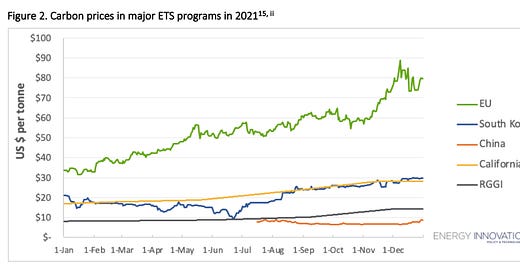Over the past few months I have reposted a number of articles from the Carbon Risk archives. The subscriber base for Carbon Risk has grown significantly over the past year and so many current readers probably haven’t seen some of the earlier articles. Many of the posts are arguably even more relevant now than the day they were first published. Following that theme, this months repost focuses on China’s national carbon market which recently passed two years since its launch in July 2021.
China’s carbon price hit a record high of 72.85 yuan per tonne last week. The price of emission allowances have surged by over 40% since April as the government has encouraged obligated emitters (>2000 eligible power generators) to secure sufficient allowances by the end of 2023. In order to avoid last minute volatility power stations are being encouraged to cover 85% of their annual emissions by 15th November.
Equivalent to ~€9.30 per tonne, China’s carbon market is clearly a long way short of the €85-90 per tonne that carbon allowances trade for in the EU. The 10-fold difference is likely to become ever more important as the EU’s carbon border tax (CBAM) is gradually introduced beginning in 2026. China is expected to be one of the most heavily exposed countries to the trade in carbon intensive products to Europe. The policy is likely to accelerate plans to expand China’s ETS to industrial sectors such as steel manufacturing.
As this article serves to highlight, China’s unique design of emissions trading scheme is designed in a way that can result in very different outcomes than conventional schemes such as the EU ETS for example. As recent trends suggest, China’s market is entirely consistent with new coal powered plants being constructed.
China hosts the world’s largest carbon market by emissions. One year ago, almost to the day, trading in carbon allowances began changing hands.
Over 2,100 liable coal and gas power stations participate in the compliance scheme, covering about 4.5 billion tonnes carbon dioxide (CO2e) per year - around 40% of China’s total annual emissions.
China’s allocation of emissions allowances is based on emissions intensity - each allowance represents the right to emit one tonne of CO2e. Allowances are allocated according to actual production levels of coal and gas fired power plants (e.g. kWh of electricity generated) and predetermined emissions intensity benchmarks (e.g. CO2/kWh).1
This is very different from the approach taken by other emissions trading schemes (ETS) such as the EU’s where there is an absolute emissions cap. The design of the ETS is in line with China’s decarbonisation ambitions under its Nationally Determined Contribution (NDC), which includes a 65% reduction in carbon emission intensity (carbon emitted per yuan of GDP) by 2030, versus 2005 levels.


